Physics elevator problems and solutions – 5 elevator case studies
Last updated on June 2nd, 2023 at 12:50 pm
In this topic, we will see an application of Newton’s Second Law in 5 selected cases of Elevator movement, which will help us to solve elevator problems in Physics with ease. From Newton’s Second Law, we can derive the equation of Force. If F is the net force applied on an object of mass m and the mass moves with an acceleration ‘a‘ then the equation goes like this, F = m a.
To solve these elevator problems in physics students need to understand a couple of terms first like Normal Reaction, Weight, Net Force, and Acceleration.

Normal Reaction
When an object is kept on a surface, its weight (W = mg) acts downwards towards the center of the earth. Here m is the mass of the body and g is the acceleration due to gravity.
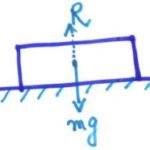
The surface in turn gives a Reaction Force (R). This Reaction works in a line perpendicular to the surface towards the object.
If the surface is a horizontal surface like the floor of the elevator, then the normal reaction acts just in the opposite direction but in the same line of action as Weight.
Hence this reaction force is also known as Normal Reaction Force. In fact, because of this Reaction Force, we feel our Weight. In SI, its unit is Newton. (It’s a force, after all !)
Normal Reaction in an Elevator in different situations [Elevator problems in Physics]
Say a person is standing in an Elevator. his weight is acting downwards towards the floor of the elevator. The elevator surface in turn is applying a Reaction force. Let’s start with our case studies from here, with this understanding. Note that the movement is possible in the Y direction or vertically only, for the elevator system we are considering.
Also pls note that for the 5 case studies listed below, the observer is considered to be on a non-accelerating Inertial frame of reference.
Find out the Normal reaction in a stationary elevator [Case Study I]
Stationary elevator means The elevator is not moving.
The weight of the person (W) and reaction force (R) are the only acting forces on the person at this moment. As there is no movement, it’s pretty clear that there is no change of velocity, therefore no existence of acceleration. W and R are nullifying each other.
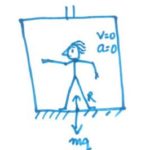
So the net force = W + (-R), here sign of R is taken with a negative sign to consider its direction which is opposite to W.
Therefore, net force = W – R.
As there is no net force i.e. Net force ∑Fy=0, so we can write the formula this way: W – R = 0
so, R = W.
This means the reaction is equal to the weight of the person itself. So the person will feel the same weight he feels generally.
Find out the Normal reaction in an elevator with constant velocity [Case Study 2]
The elevator is moving with constant velocity.
This movement may be upwards or downwards. Like case 1, here also there is no acceleration of the system as its moving with constant velocity.
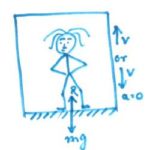
So no net force acting on the system. ∑Fy=0.
Here, the total force along the Y axis is W + (-R) = W – R.
And W – R = 0. So R = W.
This is the same feeling of Reaction force for the person inside the lift, which is just equal to his Weight.
Find out the Normal reaction in an elevator moving upwards with an acceleration [Case Study 3]
The elevator is now moving upwards with an acceleration say a.
So obviously in this case there will be a non-zero net force working on the system.
As the elevator is moving upwards, i.e. in the direction of Reaction force, therefore the net force would be R – W upwards. Following the equation obtained from Newton’s second law (Net force=mass X acceleration), we can write here:
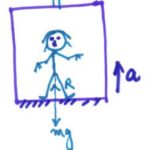
R – W = m a
or, R – mg = ma
or, R = m(a +g)
So it’s very clear that, unlike the first two cases, the Reaction force is no more equal to the Weight only. Now it’s more than the Weight of the person.
Therefore in this case the person will feel heavier than his normal weight.
Find out the Normal reaction in an elevator moving downwards with an acceleration [Case Study 4]
The elevator is now moving downwards with an acceleration a.
So again in this case there will be a non-zero net force working on the system.
As the elevator is moving downwards, i.e. in the direction of Weight, therefore the net force would be W – R downwards.

Following the equation obtained from Newton’s second law of motion (Net force=mass X acceleration), we can write here:
W – R = m a
or, mg – R = ma
or, R = m (g – a)
So it’s evident that the Reaction force is not equal to the Weight in this case as well. Now it’s less than the Weight of the person.
Therefore in this case the person will feel lighter than his normal weight.
Find out the Normal reaction in a freely falling elevator [Case Study 5 – elevator free fall]
This is a special case.
Say due to some reason the rope of the elevator is torn.
Naturally, without any other support available, the elevator is now moving downwards.
(free-fall)
And it’s going downwards with an acceleration g (9.8 m/s^2) due to the effect of gravity. (free fall)
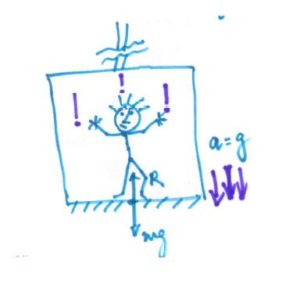
The elevator is on a FREE FALL with an acceleration equal to the acceleration due to gravity (g). So again in this case there will be a non-zero net force working on the system.
As the elevator is moving downwards, i.e. in the direction of Weight, therefore the net force would be W – R downwards. Following the equation obtained from Newton’s second law of motion (Net force=mass X acceleration), we can write here:
W – R = m g
( Note: we have used g instead of a)
=> mg – R = mg
or, R = m (g – g)=0
So it’s evident that the Reaction force is 0 this time and the person inside will feel weightless.
Related Posts: Pseudo force and Elevator physics
Case Study with Pseudo force [Elevator problems in Physics]
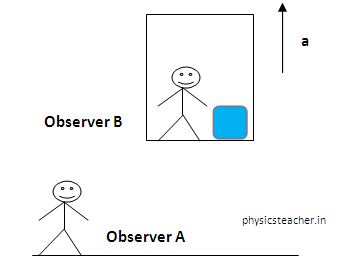
Now as said above the above-listed case studies are analyzed considering the observer is on an inertial frame of reference.
We have discussed one more interesting elevator case study with respect to an observer who is in a non-inertial frame of reference. We have applied the concepts of Pseudo force to apply Newton’s laws in that case.
**Read the complete case study here:
Elevator case study wrt Non-inertial frame of reference
**One set of numerical elevator problems is listed in the following paragraph. Please note: who is searching for Lift problems this tutorial will help you.
Lift Numerical problems class 11 | elevator Numerical worksheet [ Practice Questions]
1) An object of 100 Kg mass is kept on an elevator surface. The elevator is moving with a constant velocity of 3 meters per second. What is the normal reaction to the object in Newton?
Solution:
velocity of the elevator is constant. In this case, the normal reaction to the object = weight of the object.
Hence, Normal Reaction to the object = mg = 100 x9.8 N = 980 N
2) A 40 Kg boy is moving upwards in a lift with an acceleration of 2 meters/second^2. What would be the weight felt by him, if measured on a scale?
Solution: the weight felt by the boy = normal reaction R to the boy.
In this case, R = m(g+a) = 40 (9.8 + 2) = 472 N
3) A 70 Kg old person is moving downwards in an elevator with an acceleration of 3 meters/second^2, What would be the Normal Reaction on him applied by the elevator ground surface?
Solution: In this case, R =m (g-a) = 70 (9.8-3) N = 476 N
